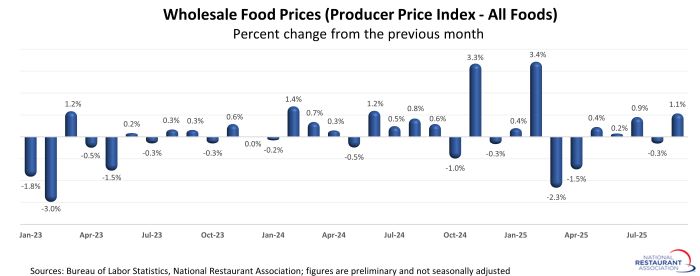Food Costs
Average wholesale food prices rose sharply in September, according to preliminary data from the Bureau of Labor Statistics. The Producer Price Index for All Foods – which represents the change in average prices paid to domestic producers for their output – jumped 1.1% between August and September.
September represented the fourth increase in the last five months and the 1.1% gain was the largest since February (+3.4%).
Prior to the recent upturn, the food price index had declined in both March (-2.3%) and April (-1.5%), which offered temporary relief from the rising food costs.

After the increase in September, the food price index stood 4.2% above year-ago levels. That was down from the strong 9.7% increase during the 12 months ending in February, but it represented the continuation of a prolonged period of rising food costs.
That will keep pressure on the bottom line of restaurants, as operators continue to struggle with elevated costs in other areas.
Wholesale food prices continue to rise well above their pre-pandemic levels. As of September 2025, the Producer Price Index for All Foods stood 38% above its February 2020 reading.

The overall food price index was more than 4% above year-ago levels, but trends were mixed on the individual commodity level.
Producer prices for unprocessed finfish (63.2%), beef and veal (38.7%), coffee (32.1%), confectionary materials (8.3%), fats and oils (6.4%), pork (5.6%), unprocessed shellfish (5.4%) and fresh vegetables (5.2%) stood well above their September 2024 levels.
At the same time, there was a degree of pricing relief for some commodities in recent months. The price indices for butter (-33.4%), eggs (-28.7%), milled rice (-8.3%), fresh fruit (-8.1%), refined sugar (-6.6%), wheat flour (-6.4%), cheese (-6.4%) and milk (-5.0%) were down from year-ago levels.
While food costs remain a headwind overall, the degree to which restaurants are experiencing any pricing relief depends on the menu mix of each individual operation.